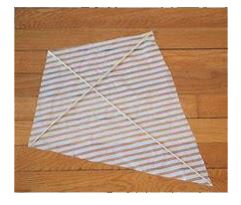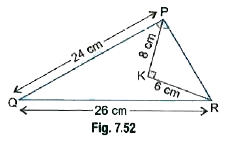If in a triangle, square of one side is equal to the sum of squares of the other two sides, then the angle opposite the first side is :
60∘
90∘
45∘
30∘
The correct Answer is:B
To solve the problem, we need to determine the angle opposite to a side in a triangle when the square of that side is equal to the sum of the squares of the other two sides. This is a direct application of the Pythagorean theorem.
1. Understand the Given Condition:
We are given that in a triangle, the square of one side (let's call it a) is equal to the sum of the squares of the other two sides (let's call them b and c). Mathematically, this can be expressed as:
a2=b2+c2
2. Identify the Triangle:
Let's denote the triangle as △ABC where:
- Side a is opposite angle A
- Side b is opposite angle B
- Side c is opposite angle C
3. Apply the Pythagorean Theorem:
The equation a2=b2+c2 is the Pythagorean theorem, which states that in a right triangle, the square of the length of the hypotenuse (the side opposite the right angle) is equal to the sum of the squares of the lengths of the other two sides.
4. Determine the Angle:
Since a2=b2+c2, it indicates that angle A (the angle opposite side a) must be a right angle. Therefore:
∠A=90∘
5. Conclusion:
Thus, the angle opposite the first side (side a) is:
Angle opposite the first side =90∘
Final Answer:
The angle opposite the first side is 90∘.
---
We are given that in a triangle, the square of one side (let's call it a) is equal to the sum of the squares of the other two sides (let's call them b and c). Mathematically, this can be expressed as:
a2=b2+c2
Let's denote the triangle as △ABC where:
- Side a is opposite angle A
- Side b is opposite angle B
- Side c is opposite angle C
The equation a2=b2+c2 is the Pythagorean theorem, which states that in a right triangle, the square of the length of the hypotenuse (the side opposite the right angle) is equal to the sum of the squares of the lengths of the other two sides.
Since a2=b2+c2, it indicates that angle A (the angle opposite side a) must be a right angle. Therefore:
∠A=90∘
Thus, the angle opposite the first side (side a) is:
Angle opposite the first side =90∘
The angle opposite the first side is 90∘.
Topper's Solved these Questions
- TRIANGLESBOOK - MBD -HARYANA BOARDCHAPTER - TRIANGLESEXERCISE - FILL IN THE BLANKS
4 Videos
- TRIANGLESBOOK - MBD -HARYANA BOARDCHAPTER - TRIANGLESEXERCISE - SHORT ANSWER TYPES QUESTIONS
9 Videos
- SURFACE AREAS AND VOLUMESBOOK - MBD -HARYANA BOARDCHAPTER - SURFACE AREAS AND VOLUMESEXERCISE - LONG ANSWER TYPE QUESTIONS
16 Videos
Similar Questions
Theorem 6.9 : In a triangle, if square of one side is equal to the sum of the squares of the other two sides, then the angle opposite the first side is a right angle.
View SolutionConverse of Pythagoras theorem : In a triangle; If the square of one side is equal to the sum of the squares of the other two sides., then the angle opposite to the side is a right angle.
View Solution
Knowledge Check

Rahul is studying in X Standard. He is making a kite to fly it on a Sunday. Few questions came to his mind while making the kite. Give answers to his questions by looking at the figure
In a triangle, if square of one side is equal to the sum of the squares of the other two sides, then the angle opposite the first side is a right angle. This theorem is called as,APythagoras theoremBThales theoremCConverse of Thales theoremDConverse of Pythagoras theoremIn a traingle, if square of one side is equal to the sum of the squares of other two sides, then the angle opposite the fitst side is :
A60∘B90∘C45∘D30∘In a right-angled triangle, the square of the hypotenuse is equal to twice the product of the other two sides. One of the acute angles of the triangle is
A60∘B45∘C30∘D15∘
In a triangle, if the square on one side is equal to the sum of the squares on the other two sides, prove that the angle opposite to the first side is a right angle. Use the above theorem to find the measure of ∠PKR in Fig. 7.52.

View SolutionIf the square of one side of a triangle is equal to the sum of the squares of the other two sides then the triangle is a right triangle with the angle opposite the first sides as right angle.
View SolutionProve that in a right triangle, the square of the hypotenuse is equal to the sum of the squares of the other two sides.
Use the above theorem, in the following.
If ABC is an equilateral triangle with AD⊥BC, then prove that AD2=3DC2.
View SolutionIn aright angled triangle, the square of the hypotenuse is equal to to the sum of squares on the other two sides, prove. Using the above theorem, determine the length of AD in terms of b and c.
View SolutionTheorem 6.8 : In a right triangle, the square of the hypotenuse is equal to the sum of the squares of the other two sides.
View Solution
